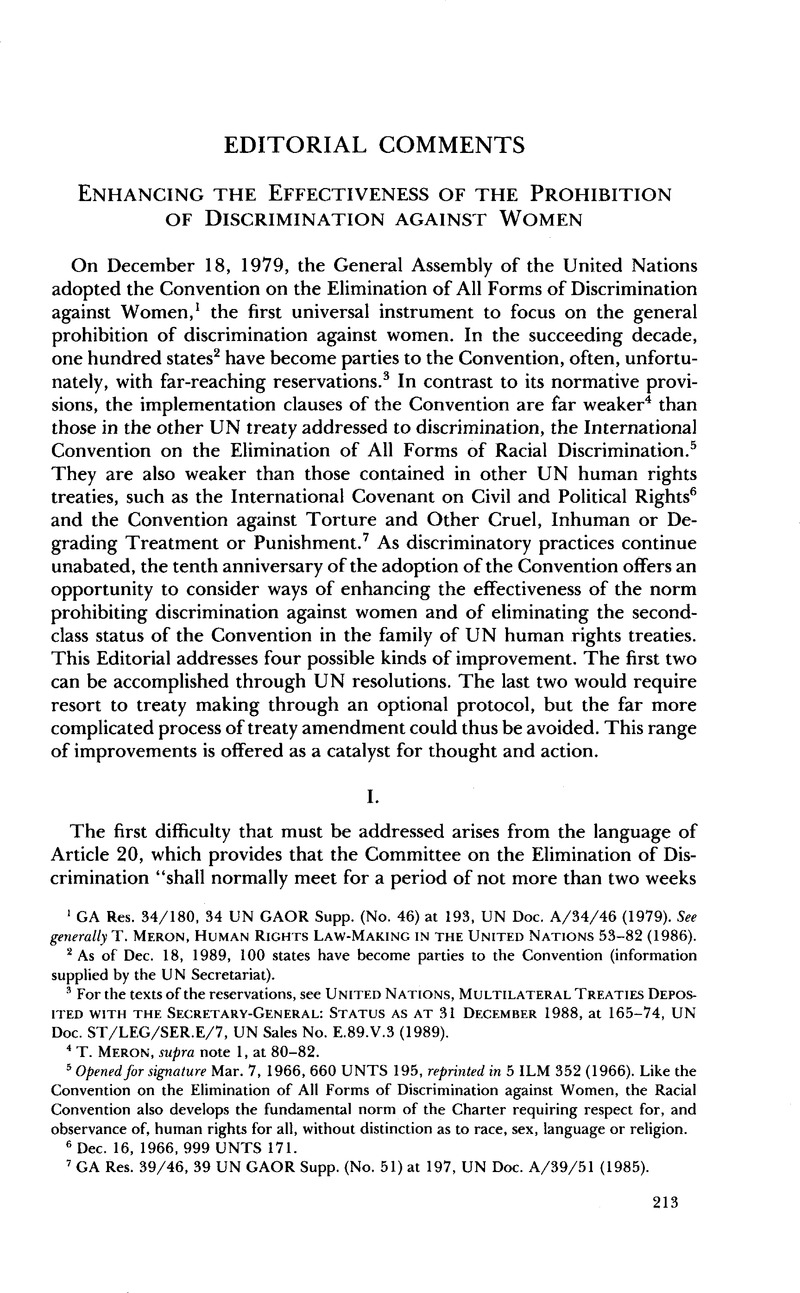Published online by Cambridge University Press: 27 February 2017

1 GA Res. 34/180, 34 UN GAOR Supp. (No. 46) at 193, UN Doc. A/34/46 (1979). See generally T. Meron, Human Rights Law-Making in the United Nations 53–82 (1986).
2 As of Dec. 18, 1989, 100 states have become parties to the Convention (information supplied by the UN Secretariat).
3 For the texts of the reservations, see United Nations, Multilateral Treaties Deposited with the Secretary-General: Status as at 31 December 1988, at 165–74, UN Doc. ST/LEG/SER.E/7, UN Sales No. E.89.V.3 (1989).
4 T. Meron, supra note 1, at 80–82.
5 Opened for signature Mar. 7, 1966, 660 UNTS 195, reprinted in 5 ILM 352 (1966). Like the Convention on the Elimination of All Forms of Discrimination against Women, the Racial Convention also develops the fundamental norm of the Charter requiring respect for, and observance of, human rights for all, without distinction as to race, sex, language or religion.
6 Dec. 16, 1966, 999 UNTS 171.
7 GA Res. 39/46, 39 UN GAOR Supp. (No. 51) at 197, UN Doc. A/39/51 (1985).
8 UN Doc. A/44/98, at 13 (1989); see also, UN Doc. A/44/38, at 14 (1989). Byrnes, The “Other” Human Rights Treaty Body: The Work of the Committee on the Elimination of Discrimination Against Women, 14 Yale J. Int’l L. 1, 27 (1989); T. Meron, supra note 1, at 81.
9 UN Doc. A/44/38, at 11 (1989).
10 Under Article 17 of the Convention, the Committee and its work are funded by the United Nations, not by states parties. See also Effective Implementation of International In struments on Human Rights, including Reporting Obligations under International Instruments on Human Rights, UN Doc. A/44/668, para. 104 (1989) (prepared by P. Alston).
11 Byrnes, supra note 8, at 36–42.
12 On the “marginalization” and “invisibility” of the Committee on the Elimination of Discrimination against Women, see also id. at 56–65.
13 However, the important contribution made to the advancement of the equality of women by the Human Rights Committee established under Article 28 of the International Covenant on Civil and Political Rights must be recognized. See, e.g., Communication No. R.9/35, Aumeeruddy-Cziffra v. Mauritius, 36 UN GAOR Supp. (No. 40) at 134, UN Doc. A/36/40 (1981), discussed in T. Meron, supra note 1, at 104, 121–22; Communication No. 172/1984, Broeks v. Netherlands, 42 UN GAOR Supp. (No. 40) at 139, UN Doc. A/42/40 (1987); General Comment 4/13, 36 UN GAOR Supp. (No. 40), supra, at 109; General Comment 18(37), UN Doc. CCPR/C/21/Rev.1/Add.1 (1989).
14 See generally Weissbrodt, The Three “Theme” Special Rapporteurs of the UN Commission on Human Rights, 80 AJIL 685 (1986).
15 See the cogent arguments by the rapporteur on torture (Professor P. Kooijmans) that his role and that of the (Convention) Committee against Torture are complementary, rather than competitive. UN Doc. E/CN.4/1988/17, at 2–4.
16 See discussion of overlapping human rights procedures in T. Meron, supra note 1, at 241–43. For a discussion of the relationship between remedies in human rights treaties and other remedies, see T. Meron, Human Rights and Humanitarian Norms as Customary Law 229–33 (1989).
17 Regarding the competence of the Commission on the Status of Women to consider communications concerning violations of human rights affecting the status of women, which appears to have had little impact, see United Nations Centre for Human Rights, United Nations Action in the Field of Human Rights 325–26, UN Sales No. E.88.XIV.2 (1988); Guggenheim, The Implementation of Human Rights by the UN Commission on the Status of Women: A Brief Comment, 12 Tex. Int’l L.J. 239, 245–48 (1977).
18 GA Res. 41/120, 41 UN GAOR Supp. (No. 53) at 178, UN Doc. A/41/53 (1987).
19 For an example of extension through a protocol of the powers of an organ established by the principal convention, see Article 4 of the Second Optional Protocol to the International Covenant on Civil and Political Rights, Aiming at the Abolition of the Death Penalty. UN Doc. A/C.3/44/L.42 (1989), adopted by GA Res. 44/128 (Dec. 15, 1989). See also UN Doc. A/44/668, supra note 10, para. 190.
20 Absent reservations, this provision is binding ipso facto on states parties upon their ratification of the Convention.
21 See also T. Meron, supra note 16,at 148–50, 194–95. Regional human rights treaties have established interstate complaints leading to binding decisions by judicial or quasi-judicial organs.
22 T. Meron, supra note 1, at 284.
23 Supra note 19.